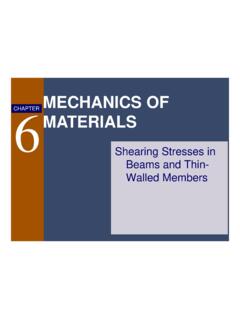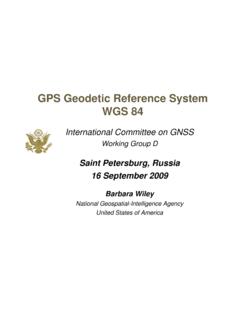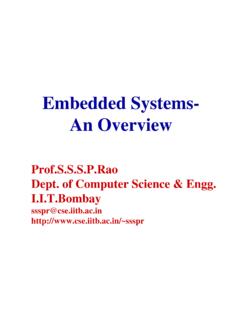Transcription of THE GLOBAL POSITIONING SYSTEM - IIT Bombay
1 THE GLOBAL POSITIONING SYSTEM . AND. ITS APPLICATIONS. Prof. Madhav N. Kulkarni, Lt. Col.(R). Department of Civil Engineering Indian Institute of Technology, Bombay . Powai, MUMBAI 400076. 2. THE GLOBAL POSITIONING SYSTEM AND ITS APPLICATIONS. CONTENTS. 1. INTRODUCTION. 2. SYSTEM DESCRIPTION. General Historical Background GPS Segments Features of GPS Satellites Principle of Operation Present status Accuracies with GPS and Comparison with other Techniques 3. SURVEYING WITH GPS. Methods of Observations Absolute POSITIONING Relative POSITIONING Differential GPS. Kinematic GPS. GPS Receivers navigation Receivers Surveying & Mapping Receivers Geodetic Receivers Computation of Coordinates Transformation From GLOBAL to Local Datum Geodetic Coordinates to Map Coordinates GPS Heights and Mean Sea Level Heights 4. APPLICATIONS OF GPS. 5. GPS IN INDIA. 6. CURRENT AREAS OF RESEARCH & FUTURE DEVELOPMENTS.
2 7. LIST OF REFERENCES. 3. Abbreviations C/A Code Coarse Acquisition Code DMA Defence Mapping Agency, DoD Department of Defense, DGPS Differential GLOBAL POSITIONING SYSTEM EDM Electronic Distance Measuring instrument GIS Geographical Information SYSTEM GDOP Geometric Dilution of Precision HDOP Horizontal Dilution of Precision IGS International GPS Service for Geodynamics ISS Inertial Surveying SYSTEM MCS Master Control Station MSs Monitor Stations NASA National Aeronautical and Space Administration, NAVSTAR GPS navigation Satellite timing & Ranging GLOBAL POSITIONING SYSTEM NCC NAVSTAR Control Centre NGS National Geodetic Survey, NNSS Navy navigation Satellite SYSTEM NSWC Naval Surface Weapons Centre P Code Precision Code PDOP Position Dilution of Precision PPS Precise POSITIONING SYSTEM PRN Pseudo Random Noise SLR Satellite Laser Ranging SPS Standard POSITIONING SYSTEM SV Space Vehicle ULS Up Load Station UTC Universal Coordinated Time VDOP Vertical Dilution of Precision VLBI Very Long Baseline Interferometry WGS World Geodetic SYSTEM 4.
3 THE GLOBAL POSITIONING SYSTEM AND ITS APPLICATIONS. 1. INTRODUCTION. The GLOBAL POSITIONING SYSTEM (GPS) is a satellite-based navigation and surveying SYSTEM for determination of precise position and time, using radio signals from the satellites, in real- time or in post-processing mode. GPS is being used all over the world for numerous navigational and POSITIONING applications, including navigation on land, in air and on sea, determining the precise coordinates of important geographical features as an essential input to mapping and Geographical Information SYSTEM (GIS), along with its use for precise cadastral surveys, vehicle guidance in cities and on highways using GPS-GIS integrated systems, earthquake and landslide monitoring, etc. In India also, GPS is being used for numerous applications in diverse fields like aircraft and ship navigation , surveying, geodetic control networks, crustal deformation studies, cadastral surveys, creation of GIS databases, time service, etc.
4 , by various organisations. The navigation Satellite timing and Ranging GLOBAL POSITIONING SYSTEM (NAVSTAR GPS). developed by the Department of Defense (DoD) to replace the TRANSIT Navy navigation Satellite SYSTEM (NNSS) by mid-90's, is an all-weather high accuracy radio navigation and POSITIONING SYSTEM which has revolutionised the fields of modern surveying, navigation and mapping. For every day surveying, GPS has become a highly competitive technique to the terrestrial surveying methods using theodolites and EDMs; whereas in geodetic fields, GPS is likely to replace most techniques currently in use for determining precise horizontal positions of points more than few tens of km apart. The GPS, which consists of 24 satellites in near circular orbits at about 20,200 Km altitude, now provides full coverage with signals from minimum 4. satellites available to the user, at any place on the Earth.
5 By receiving signals transmitted by minimum 4 satellites simultaneously, the observer can determine his geometric position (latitude, longitude and height), Coordinated Universal Time (UTC) and velocity vectors with higher accuracy, economy and in less time compared to any other technique available today. GPS is primarily a navigation SYSTEM for real-time POSITIONING . However, with the transformation from the ground-to-ground survey measurements to ground-to-space measurements made possibly by GPS, this technique overcomes the numerous limitations of terrestrial surveying methods, like the requirement of intervisibility of survey stations, dependability on weather, difficulties in night observations, These advantages over the conventional techniques, and the economy of operations make GPS the most promising surveying technique of the future. With the well-established high accuracy achievable with GPS.
6 In POSITIONING of points separated by few hundreds of meters to hundreds of km, this unique surveying technique has found important applications in diverse fields. 2. SYSTEM DESCRIPTION. 5. General The NAVSTAR GLOBAL POSITIONING SYSTEM is a satellite based navigation SYSTEM being developed and maintained by the DoD since 1972, for providing extremely accurate 3-D position fixes and UTC information to properly equipped users anywhere on or near the Earth, at any time, regardless of weather conditions. Uncertainties in positions of GPS satellite and timing signals, imposed due to security reasons by DoD, and other error sources, are expected to limit accuracy of determination of absolute position of observation station in real time mode to few meters, with few minutes of observations; however, various modes of observations and data analysis available and being developed, would yield accuracies better than few mm.
7 In relative positions for base lines up to 2000 km, with few hours of observations, at minimum cost. The SYSTEM consists of three segments: Space Segment, Control Segment and User Segment. The satellites continuously transmit dual frequency navigation signals consisting of information of satellites position with time tag, along with other data, which is periodically uploaded in satellite memory from the Control Segment. The User Segment receives navigation signals from at least 4 satellites, available any time globally, allowing the user to simultaneously solve 4 independent range-difference equations to yield his position - latitude, longitude and height and also the time. The versatility, accuracy, cost-efficiency and economy offered by the SYSTEM make GPS the most suitable SYSTEM for many different applications in various fields. Historical Background The TRANSIT NNSS - the satellite navigation SYSTEM operational prior to GPS, was launched in 1958 by the Navy.
8 It became operational in 1964 and was made available to civilian users in 1967. The SYSTEM , comprising 5 satellites at 1075 km altitude, was phased out in the early 90s. This SYSTEM has now been replaced by the NAVSTAR GPS in an extensive multi- billion dollars project launched in 1972 as a Joint Services Program of Air Force, Navy, Army, Marines and Defence Mapping Agency; in three phases. The GPS SYSTEM became fully operational and available to the commercial users by early 90s. GPS Segments The GLOBAL POSITIONING SYSTEM basically consists of three segments: the Space Segment, The Control Segment and the User Segment. Space Segment The Space Segment contains 24 satellites, in 12-hour near-circular orbits at altitude of about 20000 km, with inclination of orbit 55 . The constellation ensures at least 4 satellites in view from any point on the earth at any time for 3-D POSITIONING and navigation on world-wide basis.
9 The three axis controlled, earth-pointing satellites continuously transmit navigation and SYSTEM data comprising predicted satellite ephemeris, clock error etc., on dual frequency L1 and L2. bands (see Figs. 1 & 2). Control Segment 6. This has a Master Control Station (MCS), few Monitor Stations (MSs) and an Up Load Station (ULS). The MSs are transportable shelters with receivers and computers; all located in , which passively track satellites, accumulating ranging data from navigation signals. This is transferred to MCS for processing by computer, to provide best estimates of satellite position, velocity and clock drift relative to SYSTEM time. The data thus processed generates refined information of gravity field influencing the satellite motion, solar pressure parameters, position, clock bias and electronic delay characteristics of ground stations and other observable SYSTEM influences.
10 Future navigation messages are generated from this and loaded into satellite memory once a day via ULS which has a parabolic antenna, a transmitter and a computer. Thus, role of Control Segment is: - To estimate satellite [space vehicle (SV)] ephemerides and atomic clock behaviour. - To predict SV positions and clock drifts. - To upload this data to SVs. User Segment The user equipment consists of an antenna, a receiver, a data-processor with software and a control/display unit. The GPS receiver measures the pseudo range, phase and other data using navigation signals from minimum 4 satellites and computes the 3-D position, velocity and SYSTEM time. The position is in geocentric coordinates in the basic reference coordinate SYSTEM : World Geodetic reference SYSTEM 1984 (WGS 84), which are converted and displayed as geographic, UTM, grid, or any other type of coordinates. Corrections like delay due to ionospheric and tropospheric refraction, clock errors, etc.












